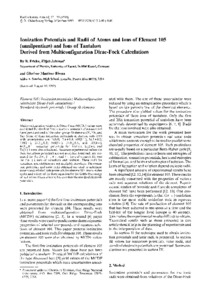| dc.date.accessioned | 2008-10-20T09:50:13Z | |
| dc.date.available | 2008-10-20T09:50:13Z | |
| dc.date.issued | 1993 | |
| dc.identifier.issn | 0033-8230 | |
| dc.identifier.uri | urn:nbn:de:hebis:34-2008102024614 | |
| dc.identifier.uri | http://hdl.handle.net/123456789/2008102024614 | |
| dc.format.extent | 749968 bytes | |
| dc.format.mimetype | application/pdf | |
| dc.language.iso | eng | |
| dc.rights | Urheberrechtlich geschützt | |
| dc.rights.uri | https://rightsstatements.org/page/InC/1.0/ | |
| dc.subject.ddc | 530 | |
| dc.title | Ionization potentials and radii of atoms and ions of element 105 (unnilpentium) and ions of tantalum derived from multiconfiguration Dirac-Fock calculations | eng |
| dc.type | Aufsatz | |
| dcterms.abstract | Multiconfiguration relativistic Dirac-Fock (MCDF) values were calculated for the first five ionization potentials of element 105 (unnilpentium) and of the other group 5b elements (V, Nb, and Ta). Some of these ionization potentials in electron volts (eV) with uncertainties are: 105(0), 7.4±0.4; 105(1 +), 16.3 ±0.2; 105(2 +), 24.3 ± 0.2; 105(3 + ), 34.9 ± 0.5; and 105(4 + ), 44.9 ± 0.1. Ionization potentials for Ta(1+), Ta(2 +), and Ta(3 + ) were also calculated. Accurate experimental values for these ionization potentials are not available. Ionic radii are presented for the 2+, 3+, 4 +, and 5+ ions of element 105 and for the + 2 ions of vanadium and niobium. These radii for vanadium and niobium are not available elsewhere. The ionization potentials and ionic radii obtained are used to determine some standard electrode potentials for element 105. Born-Haber cycles and a form of the Born equation for the Gibbs free energy of hydration of ions were used to calculate the standard electrode potentials. | eng |
| dcterms.accessRights | open access | |
| dcterms.bibliographicCitation | In: Radiochimica acta. - Muenchen : Oldenbourg, 62.1993. - S. 17-25 | |
| dcterms.creator | Fricke, Burkhard | |
| dcterms.creator | Johnson, Elijah | |
| dcterms.creator | Martinez Rivera, Glorivee | |

